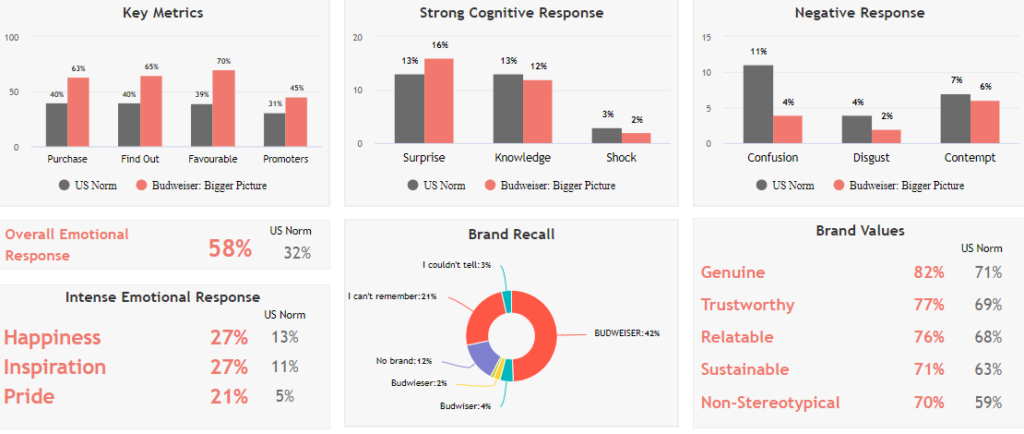Budweiser’s Sit-Out Super Bowl Campaign More Effective Than Any Big Game Ad of Last 5 Years
Seven out of 10 Americans have more favorable view of AB InBev brand after watching “Bigger Picture”, which focuses on COVID-19 vaccine awareness
NEW YORK – February 3, 2021 — A campaign created by Budweiser to announce it isn’t running an ad at the Super Bowl for the first time in almost four decades is more effective than any Super Bowl campaign of the last 5 years.
That’s according to new research from ad platform Unruly, which is using its content testing tool UnrulyEQ to measure the impact of Super Bowl LV campaigns, including how much emotional engagement they generate and the impact they have on brand metrics.
The AB InBev brand recently announced that it was taking a break from the Super Bowl after 37 years and was instead diverting the money it would have spent on airtime during the Big Game to focus on efforts to improve awareness and education around COVID-19 vaccines.
Budweiser still created an ad to announce its lack of participation. Voiced by actress Rashida Jones and created by ad agency David Miami, “Bigger Picture” features footage of Americans finding joyful moments despite the pandemic.
The ad, tested on a nationally representative sample of US consumers, achieved an EQ score of 8/10 — higher than any Super Bowl ad has managed since Unruly’s Super Bowl rankings were first launched back in 2016 and knocking Microsoft’s 2019 campaign. “We All Win” (7.5), off top spot.
Unruly’s EQ Score is a composite metric out of 10 based on a campaign’s ability to not only engage consumers but also drive brand metrics such as favorability and purchase intent.
The ad scored highly after generating an intense emotional response from 58% of viewers – almost twice the US average (32%) and overtaking 2014’s Puppy Love (55%) as the most emotionally engaging recent Super Bowl campaign from Budweiser. The campaign almost three times as likely to make people happy as the US average. It’s also three times as sad and almost three times as inspiring as the US norm.
Such a strong emotional response to the content and message also had an impact on consumers’ views of the company, with 70% saying they had a better impression of the brand after watching – 79% higher than the average US ad.
A large majority of viewers felt the brand came across as relatable (76%), genuine (82%) and trustworthy (77%).
Sixty-three per cent of viewers were also likely to buy the product, way above the average purchase intent percentage of 40%, while the number of people wanting to find out more about the campaign (65%) was also well above the US average of 40%.
However, the report also highlighted that brand recall was lower than the US average of 65%, with less than half of viewers (48%) recognizing Budweiser as the brand behind the campaign.

Rebecca Waring, Unruly’s Global VP, Insight, said: “By leveraging the Super Bowl to highlight how it’s helping with such an important and highly-visible societal issue, Budweiser’s ‘Bigger Picture’ generated the brand’s highest-ever favorability, emotional responses and purchase intent scores. The only area where the ad falls down is brand recall. Generic footage, no matter how emotive, is tricky to tie back to the brand – and consumers have seen a lot of similar ads in 2020.
“‘Bigger Picture’ drove particularly strong emotional responses and brand metrics among Budweiser’s core audience of people aged 35+, reaching an emotional response of 68% among 35-44s, with purchase intent and brand favorability both exceeding 80%. A small number of younger viewers (18-34) pointed out that despite this being a PSA-style ad, Budweiser were still using it to promote themselves. However, overall Budweiser hit the right tone and level of branding to avoid consumer cynicism.”
Methodology
Unruly analysed responses of just under 300 US consumers to Budweiser’s “Bigger Picture” campaign using its content measurement tool, UnrulyEQ. UnrulyEQ uses consumer panels and facial coding to help advertisers maximize the impact of their video content across multiple screens to more effectively land brand metrics and target receptive audiences at scale.
The results are part of a larger study around the most effective ads from Super Bowl LV, which will be ranked using the company’s proprietary EQ Score. The average Unruly EQ score is 5/10.
To get access to Unruly’s Super Bowl Hub, click here.
